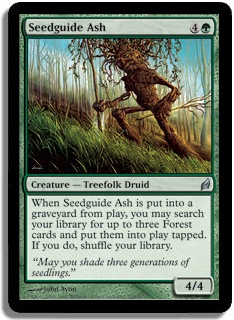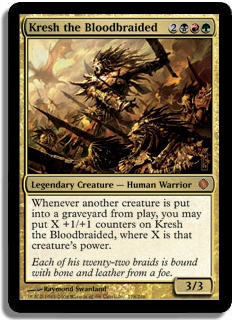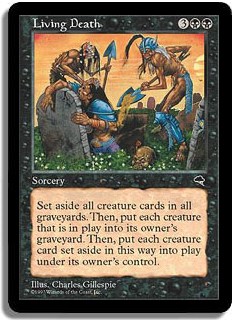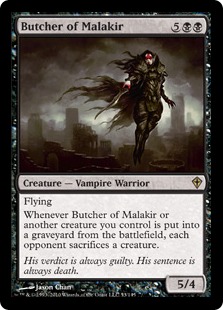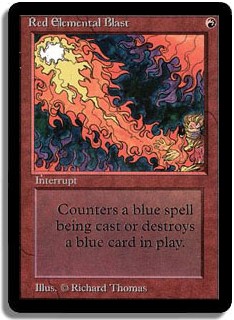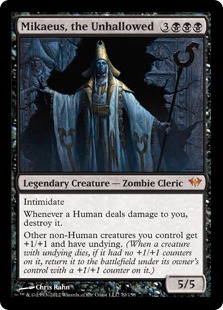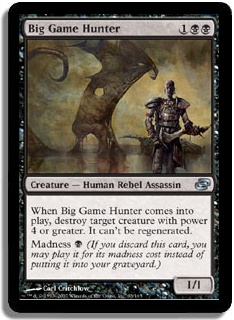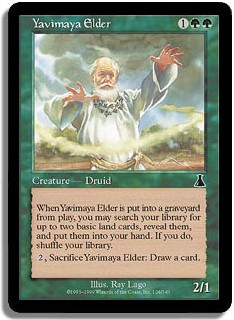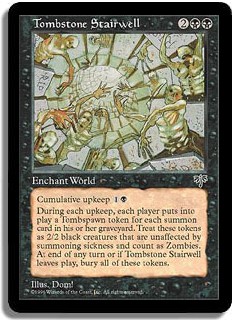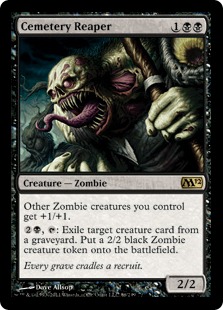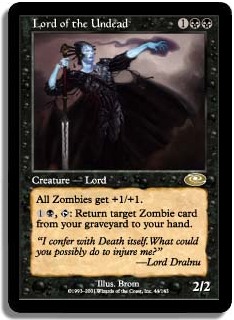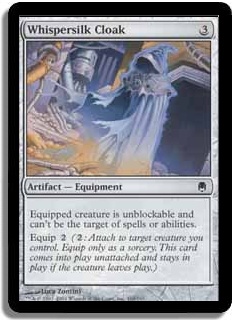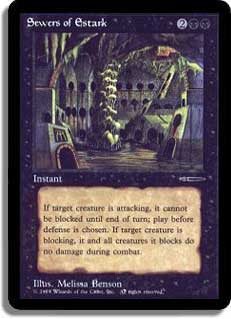Some weeks back, I did an article that broke down the lines of play and strategies for my Karador, Ghost Chieftain deck. I’d like to modify that idea a bit by talking about both the strategy of my existing Kresh deck and some other ideas on building around our favorite Warrior from different directions.
The Deck
First of all, here’s the deck that I listed on the 15th of January this year:
Creatures (32)
- 1 Solemn Simulacrum
- 1 Avalanche Riders
- 1 Withered Wretch
- 1 Eternal Witness
- 1 Yavimaya Elder
- 1 Bloodshot Cyclops
- 1 Eater of the Dead
- 1 Woodripper
- 1 Petrified Wood-Kin
- 1 Stalking Vengeance
- 1 Brooding Saurian
- 1 Greater Gargadon
- 1 Big Game Hunter
- 1 Hamletback Goliath
- 1 Farhaven Elf
- 1 Woodfall Primus
- 1 Creakwood Liege
- 1 Spearbreaker Behemoth
- 1 Madrush Cyclops
- 1 Lord of Extinction
- 1 Anathemancer
- 1 Acidic Slime
- 1 Butcher of Malakir
- 1 Pelakka Wurm
- 1 Mitotic Slime
- 1 Primeval Titan
- 1 Urabrask the Hidden
- 1 Melira, Sylvok Outcast
- 1 Scavenging Ooze
- 1 Devouring Swarm
- 1 Rune-Scarred Demon
- 1 Disciple of Griselbrand
Planeswalkers (2)
Lands (36)
Spells (29)
- 1 Tooth and Nail
- 1 Living Death
- 1 Sol Ring
- 1 Regrowth
- 1 Demonic Tutor
- 1 Red Elemental Blast
- 1 Goblin Bombardment
- 1 Skullclamp
- 1 Victimize
- 1 Spore Cloud
- 1 Scrabbling Claws
- 1 Grab the Reins
- 1 Fling
- 1 Survival of the Fittest
- 1 Greater Good
- 1 Skyshroud Claim
- 1 Pernicious Deed
- 1 Tormod's Crypt
- 1 Krosan Grip
- 1 Makeshift Mannequin
- 1 Necrogenesis
- 1 Lurking Predators
- 1 Basilisk Collar
- 1 Momentous Fall
- 1 Cultivate
- 1 Mimic Vat
- 1 Darksteel Plate
- 1 Praetor's Grasp
- 1 Command Tower

Here are the changes since then:
January 25:Â In:Â Flayer of the Hatebound, Feed the Pack, Grim Backwoods, Strip Mine, Taiga. Out:Â Darksteel Plate, Scrabbling Claws, Tooth and Nail, Mountain, Wasteland.
This change obviously came in the aftermath of the Dark Ascension release. The two spells are excellent with the strategy of the deck. Scrabbling Claws came out for a land because I had been experiencing a few mana difficulties and still had enough graveyard hate. Taiga and Strip Mine are obvious upgrades from Mountain and Wasteland. I didn’t take out a colored mana producer to simply add Strip Mine because there are enough colorless lands already. The deck likes its colors.
April 24:Â In:Â Malignus, Essence Harvest, Seedguide Ash, Inferno Titan, Harvester of Souls. Out:Â Brooding Saurian, Garruk Primal Hunter, Creakwood Liege, Basilisk Collar, Petrified Wood-kin.
Three Avacyn Restored cards came in, all of them saucy. Essence Harvest might be the best thing to have happened to the deck in a while. I’d been waiting for a while to put in Seedguide Ash and finally found a foil one. Inferno Titan just felt like something I’d want to play, and it’s paid great dividends. Other than Brooding Saurian, which I took out simply because folks had lately stopped stealing stuff so much, the others were just cards that I had played before and wanted to try new stuff. In any Eternal format, especially Commander, new things will come along that you want to play with, and that means chucking stuff you might still love.
May 30:Â In:Â Tangle, Graven Cairns. Out:Â Spearbreaker Behemoth, Akoum Refuge.
In the post-Craterhoof Behemoth world, I wanted another Fog, which is why Tangle now accompanies Spore Cloud. The cool Future Sight version of Graven Cairns is just cool and doesn’t come into play tapped. The one point of life gain from the Refuge isn’t that significant in a deck that can gain life in huge chunks (Essence Harvest, Momentous Fall).
There’s one other change, but it’s only temporary. While we’re testing Kokusho in the Armada Games League, I’ve replaced Melira, Sylvok Outcast with The Evening Star. I felt a little dirty playing Melira with Woodfall Primus and Goblin Bombardment, so I didn’t mind actually taking it out. When the KK test is over, Melira probably doesn’t go back in anyway—it will certainly be replaced by M13’s Disciple of Bolas.
The Strategy
Kresh is the most one-shot deck I have. There are tremendous synergistic elements that drive the basic strategy: through the use of mid- to large-sized creatures and sacrifice outlets, get Kresh huge, then get into the Red Zone. The secondary part of that plan is to use cards like Fling (I count Bloodshot Cyclops as a second Fling), Grab the Reins, and Essence Harvest to dome people for extreme amounts. Kresh isn’t the only creature that can become quite large:Â Hamletback Goliath will get insane pretty quickly. A mid- or late-game Lord of Extinction can also be quite something. Attacking one player for the kill and then Flinging something huge to kill a second (perhaps following up with a third off of a Stalking Vengeance trigger) has happened quite frequently.
The backup strategy is Living Death. There’s enough graveyard hate and sacrifice outlets to make (with a little planning) Living Death quite one-sided. I’ve certainly taken down my fair share of games in that fashion, but the deck is solid enough that I don’t try to rush to that end. There’s no real need for an all-in Living Death strategy (which could end up badly for me, especially with a Tormod’s Crypt or Relic of Progenitus). I prefer to rely on the other tricks and then make Living Death punishment for sweeping the board.
The Tools
In addition to enough ramp to get the deck going, the main tools are the enchantments. My regard for Greater Good is well known. Survival of the Fittest is great for loading up the graveyard or just getting the right creature into play, although again, I’m a little careful about dumping too much too quickly, lest I get murdered by cheap graveyard devastation. Lurking Predators provides value (getting stuff for free is value, right?) with 36 creatures in the deck. I’ve yet to take too much advantage of Feed the Pack since I haven’t been playing it that long, but in theory, it feeds the graveyard strategy while still letting me hang on to a number of creatures.
There are a few creature control elements that help pave the way for Kresh attacking. My favorite of these is Butcher of Malakir combined with a sacrifice outlet. Once the ramp and utility creatures (like Farhaven Elf, Wood Elves, Acidic Slime, and Solemn Simulacrum) have done their jobs, they can be sacrificed to help clear the way. Big Game Hunter will take out fatties and, like many other cards in the deck, simultaneously make Kresh larger. Pernicious Deed clears the way of the smaller guys (plus once again making Kresh large—I especially like cracking it for zero to wipe out tokens).
Mikaeus, the Unhallowed can certainly be a wrecking ball paired with any number of creatures in the deck. That said, my favorite single-card strategy in the deck is Red Elemental Blast. It never fails to be just what the doctor ordered.
The Weaknesses          Â
While the deck can do big things, isn’t particularly fast. I suppose there is a turn 1 Sol Ring, turn 2 Skyshroud Claim play that gets me going quickly, but the numbers don’t favor that happening that often (plus, turn 1 Sol Ring is a negative point in the League). By the time the deck really can get rolling, in the turn 6-8 range, other decks may have gotten a bigger jump in the curve. There aren’t that many times when I find myself so far behind, but it can happen.
Other than the few things I mentioned above, the deck doesn’t have board sweepers or significant creature control. It’s not significantly important since my creatures are always pretty good, but there are certainly times when I’d like to have a Wrath effect and I’m left wanting.
The deck doesn’t like graveyard hate since that takes away the backup plan (plus making Mikaeus a little awkward), but it doesn’t absolutely roll to it. The threat density is moderately high without resorting to the graveyard.
Blink effects, in which I’ll kind of include Mystifying Maze, are similarly annoying for two reasons. First, they reset the counters on cards like Kresh and Hamletback Goliath. Second, the best of the deck’s weapons come to bear when creatures die, not when they enter the battlefield.
I’d call the deck’s mana greediness a weakness, although there’s a point of diminishing returns around 11-12 mana where too much more isn’t so much better (unless Kessig Wolf Run is also in play).
If there’s a weakness to Mikaeus, it’s that there are enough Humans in the deck to be occasionally irritating. Kresh himself is significant one, along with Avalanche Riders, Big Game Hunter, Disciple of Griselbrand, Eternal Witness, and Yavimaya Elder.
All in all, the deck plays rather similarly every time, which makes it a great choice to not play all that often. That way, I don’t tire of the experience.
Other Kresh Strategies
You see how I’ve built my Kresh deck, but there are certainly other ways to build around this build-around commander. Sure, they all revolve around getting Kresh pretty large, but that’s what he does.
Kresh and His Zombies
Although some of the newer, really interesting Zombies are blue/black (Diregraf Captain, Grimgrin, Corpse-Born, Havengul Lich), there are some great red/black ones as well (Anathemancer, Bladewing the Risen, Deathbringer Thoctar, Pyre Zombie). There are any number of Zombies that play well with Kresh, like Apprentice Necromancer, Carrion Feeder, Corpse Harvester, Golgari Rotwurm, Nantuko Husk, Shambling Shell, Stronghold Assassin, and the very janky Waning Wurm. Remember that Chameleon Colossus, Taurean Mauler, Cairn Wanderer, and Changeling Titan are all playable Zombies.
The card that got me headed down this path is Tombstone Stairwell. Now maybe using Survival of the Fittest to fill up the graveyard quickly is more viable. The tokens are destroyed at end of turn, which means they buff up Kresh—even more so if you have Cemetery Reaper or Lord of the Undead in play. With only Kresh in play and two creatures in everyone’s graveyard, Kresh will be +36/36 by the time it gets back around to your turn.
Kresh-imundar
You could take a page out of the Thraximundar decks that just like to sacrifice stuff. You can still have favorites like Greater Good and Greater Gargadon. Bloodfire Colossus is absurd because the cost of activating the ability is sacrificing it, meaning it will trigger Kresh’s ability, making him large enough to survive the six damage. Minion Reflector becomes pretty crazy, then adding Puppeteer Clique on top of it even crazier (although you’ll need to make use of one of your sacrifice outlets). Make small guys (or your utility/ramp guys) and sacrifice them to Attrition. Add the dual package of Butcher of Malakir and Grave Pact (the awesome 8th Edition art being the best: "YOU! GET IN THE GRAVE!!!) and you can make an environment pretty hostile to other players’ creatures—leaving Kresh to swing through for general damage wins.
Just Jund
Black/red/green is an aggressive color combination. You might be able to get some mileage out of doing things the colors do—ramp and make dudes, blow up creatures, and blow up other stuff. It’d be an interesting experiment to watch Kresh as a general working in a deck that’s not built specifically around him. When there are creature combats, Kresh is going to benefit.
Kresh Kontrol
My deck and the Kresh-imundar above are mostly focused on sacrificing your own guys (with a collateral benefit of sometimes costing them dudes), but you could change the focus toward being hostile toward their guys. Avatar of Woe, Big Game Hunter, Bone Shredder, Bounty Hunter, Dark Hatchling, Hunter of Eyeblights, Kalitas, Bloodchief of Ghet, Tsabo’s Assassin, and Visara the Dreadful are all creatures that destroy other creatures. Kaervek the Merciless lets you take out creatures when other people cast spells (note that what you target with Kaervek doesn’t have to be controlled by the opponent who cast it). There’s obviously the whole suite of black creature destroyers: Terror, Dark Banishing, Doom Blade, Bone Splinters, Crushing Vines, and the out-of-nowhere blowout of Fatal Blow are just a few of the 30+ choices you have.
Although they get a little pricey, you actually have some sweeper-like answers in the colors that won’t kill your own guys. Do or Die, Dread Cacodemon, Extinction, Forced March, Overwhelming Forces, Plague Wind, Rain of Daggers (although you have to be careful there), and Tsabo’s Decree will get you there. You can also get some mileage out of Hurricane-like effects that destroy just creatures with flying such as Tornado Elemental and Whirlwind. As we discussed above, Pernicious Deed, used judiciously, can destroy large numbers of creatures and still keep Kresh alive.
You can move into the conventional board sweeper plan with Damnation, Decree of Pain, and friends, but you’ll have to have some way to make Kresh indestructible. Darksteel Plate is the cheap and easy way to do this. If you want to go the route of board sweepers through damage, like Earthquake or Blasphemous Act, simply run ways to regenerate Kresh. Asceticism is a nice choice, but you also have Yavimaya Hollow, the criminally-underused Broken Fall, the life gaining Heal the Scars, Medicine Bag, Refresh, Regenerate, Sporeback Troll, Resuscitate, Savage Silhouette, Skeletal Grimace, and the completely hidden gem Run Wild, where for two mana you can give him both trample and regenerate. Totem Armor cards like Bear Umbra will also keep Kresh alive through the destruction of the rest of the board and lead to a huge attack.
Focused General Damage
I call this "The Whispersilk Cloak plan." It can be an adjunct to other plans as well. Use the Cloak or little-used old cards like Tracker and Sewers of Estark to make him unblockable. Combine with hexproof-granting things like Swiftfoot Boots and Asceticism to keep people’s hands off. Hexproof is better than shroud (obv) because you’re still going to want to do things like use Kessig Wolf Run and Berserk and other targeted spells that make him huge.
Don’t underestimate the value of Champion of Lambholt to get your Kresh through as well. Perhaps some "creatures must attack" stuff like Gratuitous Violence helps open attack lanes, then add double strike with Avatar of Slaughter or Psychotic Fury, an old favorite. Extra attack steps may push this completely over the top on the backs of cards like Savage Beating, Aggravated Assault, Hellkite Charger, Relentless Assault, Seize the Day, and World at War. Last of all, don’t forget Boldwyr Intimidator, since Kresh is indeed a Warrior.
+1 Counters Matter
Rip the idea from Animar decks that the counters matter. Forgotten Ancient is the big daddy because you can transfer them over to Kresh when you like. There are the Spikes (especially Spike Feeder and Spike Weaver) for both moving counters and utility. Blade of the Bloodchief is going to get counters onto Kresh when you use some of the color’s elements to destroy creatures.
Shambling Shell, Golgari Guildmage, Hunger of the Howlpack, Hunting Moa, and Incremental Growth, will help you get there in small steps, as will graft creatures like Cytoplast Root-kin. You can step it up a little more with Thrive and Borborygmos, then bigger piles with Decree of Savagery. Of course, you can’t neglect Doubling Season, which obviously makes a nice addition to any Kresh deck.
Little Kresh Riding Hood
I’ll concede that this might be going down the theme road a little too far, but I’ll nonetheless suggest a Kresh deck with all the elements of the classic fairy tale (perhaps even expanded from the idea of ABC’s Once Upon a Time). Wolves and Werewolves are definitely a major part of the theme, and then adding a Witch or two, some Hunters and Trackers (there are 20+ Rangers, although not all in the colors), and the fight mechanic. Boom! Storytelling night. Â Â
Kresh Vampires
How good is the marriage of Kresh and Olivia Voldaren? You might have to scale back a bit of the Vampire tribal theme to include some of the green stuff you’d need to make Kresh cool. I’d actually start with fellow RC member Scott Larabee’s Olivia deck (presented here), taking out some of the things I simply don’t like playing (Sorin, Wound Reflection, Exsanguinate, and a few others) to make room for a little bit of ramp and obviously the green to cast Kresh. How interesting might Kresh Vampires be if Kresh is the ONLY green you have (easily doable with original duals, shocklands, fetchlands, and Tainted Wood)? I might just build that.
Although at first, Kresh seems like a narrowly focused commander to build around, hopefully we’ve explored some wider, Chaos-Embracing options to inspire you toward building and playing outside the box.


